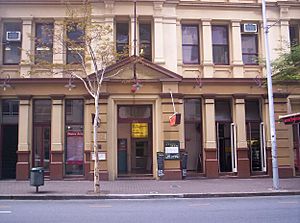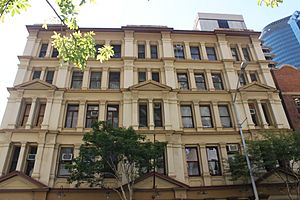Metro Arts Theatre facts for kids
Quick facts for kids Metro Arts Theatre |
|
|---|---|

Entrance of Metro Arts Theatre, 2005
|
|
| Location | 117 Edward Street, Brisbane City, City of Brisbane, Queensland, Australia |
| Design period | 1870s–1890s (late 19th century) |
| Built | 1890 |
| Official name: 109 Edward Street, Community Arts Centre, Coronation House, Metro Arts Centre | |
| Type | state heritage (built) |
| Designated | 21 October 1992 |
| Reference no. | 600090 |
| Significant period | 1890 (fabric) 1890–1930, 1938–1949, 1949–1976, 1981 (historical) |
| Significant components | carriage/wagon/dray entrance, hoist |
| Lua error in Module:Location_map at line 420: attempt to index field 'wikibase' (a nil value). | |
The Metro Arts Theatre is a special building in Brisbane City, Queensland, Australia. It is listed on the heritage register, meaning it's an important historical place. This building, located on Edward Street, was first built in 1890 as a warehouse. A warehouse is a large building used for storing goods. Later, it became a complex with different theatres and art spaces.
Over the years, the building has been known by several names, including Community Arts Centre and Coronation House. Inside, there were theatres like the Edward Street Theatre (also called the New Edward Street Theatre), the Sue Benner Theatre, the Basement, and the Studio. The Metro Arts organisation, which ran the arts centre, moved out of this building in late 2020. The building was added to the Queensland Heritage Register on 21 October 1992 because of its historical importance.
Contents
History of the Building
The land where the Metro Arts Theatre stands was bought in 1871 by Captain George Poynter Heath. He built a large warehouse there in 1890. This warehouse was then rented to a company called George Myers & Co. This company imported many items, such as porcelain, glass, and earthenware products.
In March 1902, a fire caused a lot of damage to the upper floors of the warehouse. However, the building was later repaired. In 1907, the warehouse was divided into smaller sections to allow different businesses to rent parts of it.
By 1912, Myers & Co bought the entire building and became the only business using it. They stayed there until 1930, when their company had to close down. The building was empty for several years, from 1931 to 1937.
In 1938, the building was given a new name, Coronation House. This was to celebrate the coronation of King George VI. After this, various businesses rented space in the building, including companies that made or imported goods.
During the later part of World War II, some parts of the building were used by the Australian Government. In March 1949, the Australian Government bought the property. It continued to be used by different government departments for many years.
By the early 1970s, the building was no longer suitable for government offices. By 1976, all government departments had moved out. That same year, work began to change the building into a community arts centre.
In July 1981, the Community Arts Centre officially opened. It was a vibrant place with a theatre, two art galleries, rehearsal rooms, and spaces for workshops. It also had meeting rooms, a dark room for photography, a printing shop, a cinema, and a restaurant. More work was done in 1988 to add even more facilities for artists.
From 1980 to 1989, the Edward Street Theatre, also known as the New Edward Street Theatre, was a key part of the Community Arts Centre. Many important performances took place there, including The Cake Man by Bob Merritt and Betrayal by Harold Pinter. In 1988, the building was renamed the Metro Arts Centre.
The 21st Century
In 2017, Metro Arts had several venues inside the building. These included the Gallery, the Sue Benner Theatre, the Basement, and the Studio. It also offered multi-purpose spaces for creative businesses and individual artist studios. The first classes for the Aboriginal Centre for the Performing Arts were held in this building in January 1998.
In November 2018, it was announced that Metro Arts would be selling the building. It was sold in December 2019. Metro Arts then moved to a new location in West End, which officially opened in September 2020.
Metro Arts also had a book written and published about its history and the buildings it used. This book, called Art Starts Here: 40 Years of Metro Arts, was published in 2020.
Building Description
The Metro Arts building is a five-storey brick building, meaning it has five levels above the ground, plus a basement. Inside, the building has wooden floors and strong wooden columns that support the structure.
The front of the building, which faces the street, is called the facade. It is divided into five sections by flat, wide pilasters, which are like decorative columns built into the wall. The middle section and the two sections on the ends have tall, narrow windows that are paired together. The wider sections in between have three wider windows. All the window openings are square-shaped.
The facade also has simple classical details, with horizontal lines called string courses that divide the different floor levels.
On the ground floor, on the western side, there is an entrance for carts or wagons. This leads to an internal laneway that goes to a courtyard at the back. The top of the building has a simple parapet, which is a low wall, with stepped sections above the central and end parts. The sides of the building are plain, but they have a regular pattern of window openings.
At the back of the building, there is an internal hoist and motor. A hoist is a machine used for lifting things. It is covered by a curved corrugated iron roof and has hinged platforms at each floor level.
The building is mostly still in its original condition, especially the upper floors. You can still see the wooden columns and beams, the wooden flooring, and the brick walls. The service hoist is also still visible. Some changes have been made over time, such as removing parts of the floor structure and adding walls to create a cinema and a cafeteria.
Why it's Heritage Listed
The building at 109 Edward Street was added to the Queensland Heritage Register on 21 October 1992. This means it's considered an important part of Queensland's history and culture. It met the following important reasons:
- It shows how Queensland's history developed.
The Metro Arts Centre is important because it, along with other old warehouses from the 1800s and early 1900s, shows how big the warehousing area used to be in that part of the city.
- It shows rare or uncommon parts of Queensland's culture.
The Metro Arts Centre is a good and rare example of a warehouse built in the late Victorian era (late 1800s).
- It shows the main features of a certain type of historical place.
Again, the Metro Arts Centre is a good and rare example of a late Victorian warehouse. It helps us understand what buildings from that time were like.
- It is important for its beauty and design.
The building also looks good and helps keep the historical feel of Edward Street.
See also



